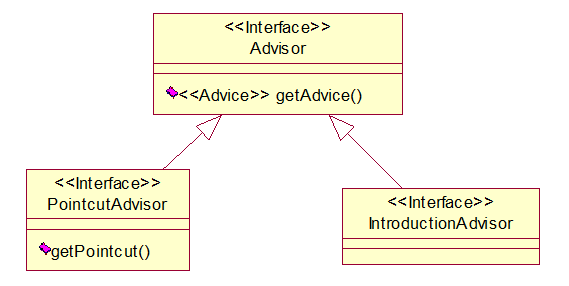2019独角兽企业重金招聘Python工程师标准>>> ![]()
主要内容:
(1)Advice接口设计
(2)MethodInterceptor接口设计
(3)Advisor和Pointcut接口设计
第一个:Advice接口设计
Advice:AOP联盟定义的通知接口,即拦截到相应的方法后执行的动作。
先看下它的类图:

(1)BeforeAdvice、AfterAdvice:SpringAOP自定义的通知,用于拦截的方法之前或者之后,继承了AOP联盟的通知接口Advice。
(2)MethodBeforeAdvice、AfterReturningAdvice:仍然是SpringAOP自己的接口设计
MethodBeforeAdvice:继承了BeforeAdvice,但是BeforeAdvice只有这一个子类,即目前的SpringAOP只能实现对方法的拦截,不能实现对字段的拦截这种更精细的拦截,而Aspectj本身是支持这种拦截的。
引入了接口方法:
void before(Method method, Object[] args, Object target) throws Throwable;即在调用target的method方法之前我们可以做一些事情。
AfterReturningAdvice:继承了AfterAdvice,引入了接口方法:
void afterReturning(Object returnValue, Method method, Object[] args, Object target) throws Throwable;必然比上面的before方法多了一个返回值Object returnValue,使得我们可以对返回值进行操作和修改。
(3)AspectJMethodBeforeAdvice、AspectJAfterReturningAdvice、AspectJAfterThrowingAdvice、AspectJAfterAdvice、:上面的接口设计好了,就需要来实现它,这几个类都是借助于Aspectj来完成上述的功能。
AspectJAfterThrowingAdvice:直接实现的是AfterAdvice,它对在它之后执行的拦截器或者目标方法的负责,若抛出异常则执行它,不抛则不执行。
AspectJAfterAdvice:则是不关心返回值,只要在后面执行就好了。
第二个:MethodInterceptor接口设计
再来看下MethodInterceptor这一重要接口,所有的advice都要最终转化成MethodInterceptor,它的invoke接口方法包含了拦截器要执行的内容及执行的顺序。
如下:

MethodInterceptor:是AOP联盟定义的接口,引入重要方法Object invoke(MethodInvocation invocation) throws Throwable;MethodInvocation invocation则像由一个个MethodInterceptor组成的链条(后面会进行说明),每次执行MethodInterceptor的invoke方法实现一个拦截,同时要把链条给它,以便继续执行下一个MethodInterceptor。
(1)AspectJAfterAdvice:在mi.proceed()之后执行,如下:
public Object invoke(MethodInvocation mi) throws Throwable {
try {
return mi.proceed();
}
finally {
invokeAdviceMethod(getJoinPointMatch(), null, null);
}
}AspectJAfterThrowingAdvice:在mi.proceed()抛出异常时执行如下:
@Override
public Object invoke(MethodInvocation mi) throws Throwable {
try {
return mi.proceed();
}
catch (Throwable t) {
if (shouldInvokeOnThrowing(t)) {
invokeAdviceMethod(getJoinPointMatch(), null, t);
}
throw t;
}
}AspectJAroundAdvice:在mi.proceed()执行过程中执行,如:
public Object invoke(MethodInvocation mi) throws Throwable {
if (!(mi instanceof ProxyMethodInvocation)) {
throw new IllegalStateException("MethodInvocation is not a Spring ProxyMethodInvocation: " + mi);
}
ProxyMethodInvocation pmi = (ProxyMethodInvocation) mi;
ProceedingJoinPoint pjp = lazyGetProceedingJoinPoint(pmi);
JoinPointMatch jpm = getJoinPointMatch(pmi);
return invokeAdviceMethod(pjp, jpm, null, null);
}这种是环绕通知,在我们自定义的方法中可以决定是否继续执行mi.proceed(),如自定义的环绕通知
public Object doAround(ProceedingJoinPoint pjp) throws Throwable {
long time = System.currentTimeMillis();
//决定是否继续链的执行
Object retVal = pjp.proceed();
time = System.currentTimeMillis() - time;
System.out.println("process time: " + time + " ms");
return retVal;
}(2)MethodBeforeAdviceInterceptor:对于上面的MethodBeforeAdvice只定义了要执行的动作,没有指定在什么时候执行,所以就需要MethodBeforeAdviceInterceptor来指定。如下:
public class MethodBeforeAdviceInterceptor implements MethodInterceptor, Serializable {
private MethodBeforeAdvice advice;
public MethodBeforeAdviceInterceptor(MethodBeforeAdvice advice) {
Assert.notNull(advice, "Advice must not be null");
this.advice = advice;
}
@Override
public Object invoke(MethodInvocation mi) throws Throwable {
this.advice.before(mi.getMethod(), mi.getArguments(), mi.getThis() );
return mi.proceed();
}
}MethodBeforeAdviceInterceptor包含了一个MethodBeforeAdvice通知,在invoke方法中指定了该通知的执行顺序,即在mi.proceed()之前执行。
对于AfterReturningAdviceInterceptor同理,如下:
public class AfterReturningAdviceInterceptor implements MethodInterceptor, AfterAdvice, Serializable {
private final AfterReturningAdvice advice;
/**
* Create a new AfterReturningAdviceInterceptor for the given advice.
* @param advice the AfterReturningAdvice to wrap
*/
public AfterReturningAdviceInterceptor(AfterReturningAdvice advice) {
Assert.notNull(advice, "Advice must not be null");
this.advice = advice;
}
@Override
public Object invoke(MethodInvocation mi) throws Throwable {
Object retVal = mi.proceed();
this.advice.afterReturning(retVal, mi.getMethod(), mi.getArguments(), mi.getThis());
return retVal;
}
}使得AfterReturningAdvice在mi.proceed()之后执行。
总结:对于advice构建成MethodInterceptor,分两种情况
(1)advice本身就实现了MethodInterceptor,如AspectJAfterAdvice、AspectJAfterThrowingAdvice、AspectJAroundAdvice。
(2)那些没有实现MethodInterceptor的advice,如MethodBeforeAdvice、AfterReturningAdvice,则会进一步转换成MethodBeforeAdviceInterceptor、AfterReturningAdviceInterceptor。这一过程又是采用适配器模式,适配器模式还是很常见的,所以要学会然后好好利用,如下面所示:
AdvisorAdapter接口:根据advice来生成不同的MethodInterceptor
public interface AdvisorAdapter {
boolean supportsAdvice(Advice advice);
MethodInterceptor getInterceptor(Advisor advisor);
}这里的Advisor包含Advice,待会再给出接口说明。
目前的AdvisorAdapter接口的实现者有三个:AfterReturningAdviceAdapter、MethodBeforeAdviceAdapter、ThrowsAdviceAdapter
AfterReturningAdviceAdapter:支持Advice为AfterReturningAdvice如下
class AfterReturningAdviceAdapter implements AdvisorAdapter, Serializable {
@Override
public boolean supportsAdvice(Advice advice) {
return (advice instanceof AfterReturningAdvice);
}
@Override
public MethodInterceptor getInterceptor(Advisor advisor) {
AfterReturningAdvice advice = (AfterReturningAdvice) advisor.getAdvice();
return new AfterReturningAdviceInterceptor(advice);
}
}如果Advisor包含的Advice为AfterReturningAdvice,则构建一个AfterReturningAdviceInterceptor(advice)作为MethodInterceptor。
其他的同理,不再分析。
第三个:Advisor和Pointcut接口设计
Advisor的类图如下:

Advisor接口本身只含有Advice,而PointcutAdvisor则是将Pointcut和Advice组合了起来。
IntroductionAdvisor后面则详细介绍。
Pointcut接口设计:

Pointcut有两个属性,ClassFilter、MethodMatcher,一个用来过滤类,一个用来过滤方法。
然后再看下Pointcut的实现类ComposablePointcut:
public class ComposablePointcut implements Pointcut, Serializable {
private ClassFilter classFilter;
private MethodMatcher methodMatcher;
}因为有时候ClassFilter、MethodMatcher 并不止一个,所以需要多个,也就是ComposablePointcut应该设计成List
拿ClassFilter来说明:
它有一个子类UnionClassFilter,这个UnionClassFilter里面含有一个ClassFilter[] filters数组,来存放所有的ClassFilter,如下:
private static class UnionClassFilter implements ClassFilter, Serializable {
private ClassFilter[] filters;
public UnionClassFilter(ClassFilter[] filters) {
this.filters = filters;
}
@Override
public boolean matches(Class clazz) {
for (ClassFilter filter : this.filters) {
if (filter.matches(clazz)) {
return true;
}
}
return false;
}
//略
}UnionClassFilter更像是一个ClassFilter集合,但它也实现了ClassFilter接口,具体的实现内容则是由内部的ClassFilter[] filters数组来实现。ComposablePointcut就会使用这种形式的UnionClassFilter。可以有不断的ClassFilter往ComposablePointcut增添,但是最终只返回一个UnionClassFilter,实现Pointcut接口时只用返回UnionClassFilter即可。
UnionClassFilter不仅具有集合的功效又实现了所需的ClassFilter功能。
ExpressionPointcut接口继承了Pointcut,引入了我们常用的Pointcut表达式,最终的实现类AspectJExpressionPointcut则又是引入AspectJ来实现。